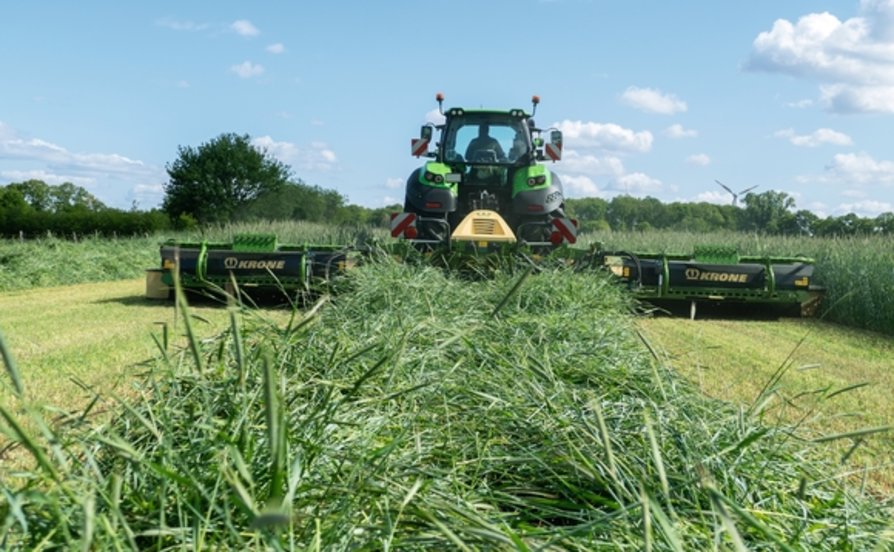Fine-tuning conditions ahead of silage-making
13 May 2024
Taking account of field conditions ahead of silage-making is vital in order to maximise quality.
Second cut presents different conditions to first cut, as the grass is more fibrous and lignified and days are longer, meaning grass will dry more quickly. Peter Smith business manager of Volac suggests farmers need to bear this in mind when deciding on wilt times:
Second cut grass is inherently drier so a 24 hour wilt is often excessive; unless the weather is wet it should be possible to pick up grass on the same day. If using a contractor, they will be able to provide feedback on their experience of optimum wilting times this season.
"If filling on top of first cut, always place a layer of fresh grass before travelling on the silage as otherwise carbon dioxide will be displaced from the silage already in the clamp, and oxygen will move in.
"Clamps should be filled in layers no deeper than 150mm and each layer rolled before adding another. Once the last layer has been rolled, it is important to place the sheet on as soon as possible and fully seal the clamp to prevent any oxygen entering," Mr Smith advises.
Check
Eleazar McKeever Sales manager from Krone urges farmers to take time to check mowers, tedders and rakes are correctly adjusted to conditions on the day.
It is vital to select the right speed on the mower conditioner. For heavy crops, the higher speed of 900 rpm is appropriate, whereas for lighter crops, the grass will need less conditioning.
"There are seven settings for the distance between the baffle plate and top of the mower. For drier crops, choose a higher setting to maintain a greater distance for less conditioning and for wetter crops, a lower setting will result in more bruising of the grass, leading to a quicker wilt".
Avoid closing it up too much as this can lead to excessive power consumption and increased fuel usage.
"Setting the correct top link length to set the pitch of the blades will determine the length of stubble left behind the crop. If mowing when the ground is soft, leaving a longer stubble length is desirable to prevent contamination," Mr McKeever explains.
Mr McKeever says tines on the tedder should be set with around 20mm tine tip to stubble, to avoid them scraping the ground:
"The pitch of each tine on Krone machines can be adjusted individually by altering the angle of the wheel between 13o and 19o. For wet, heavy crops or when making hay, a low setting will spread the grass out as far as possible; for lighter crops or for repeat tedding of a hay crop, a higher setting is recommended".
"The PTO speed for a tedder should be no faster than 450 rpm and ideally between 350 and 400 rpm with the higher revs reserved for heavier crops."
Options
If first-cut yields are disappointing or quality is below expectations, this often indicates weed grasses are out-competing sown species and a re-seed might be the best option, John Spence forage crops product manager of Limagrain UK says.
After the 2022 drought followed by a late spring, many farmers need more grass this season. Ploughing a field up now will mean taking a hit to production when grass growth is at its peak.
"A preferred option could be to boost production from existing swards by over-sowing with more productive, fast growing ryegrasses and introducing clover species".
"Alternatively, some farmers may wish to hold off re-seeding until autumn, or sow a break crop such as stubble turnips or kale to provide an autumn winter forage before re-seeding with grass".
Spring or autumn reseed?
SPRING ADVANTAGES
- Wider window of good conditions for establishment
- No heading in first season
- Better opportunity to out-compete weeds
AUTUMN ADVANTAGES
- Minimal impact on yield loss
- Seedbed has time to settle over the winter
- Gives the option of growing an intervening cover or catch crop to help control pests and diseases
SPRING DISADVANTAGES
- Loss of peak grass growth
- Shorter window for soil to settle before carrying stock
AUTUMN DISADVANTAGES
- Weed competition can be significant with late reseeds
- Narrower window of suitable establishment conditions